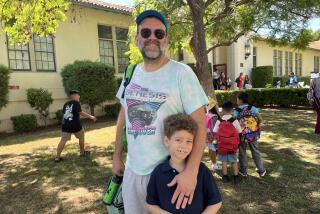‘Home of the Patriots’ Takes It Seriously
At 7:20 a.m., the middle-aged man with the cane stands at attention in the middle of the yard. He is perfectly still. This is habit now.
A few seconds later, the sound of a bugle pours out from a nearby loudspeaker. As far as two blocks away, young people stop and face the flag.
For a minute, the bugle plays. The stillness on this South Los Angeles campus is broken only by the slight smile from the man with the cane as he surveys the students frozen in place, the young imitating the old. He glances up at a mural on the nearest building.
“John Adams Middle School,” read the letters above a one-story-high rendering of a Revolutionary War soldier. And below the picture: “Home of the Patriots.”
At first inspection, Adams Middle School does not recall 18th century heroes. It is a terribly overcrowded urban school, with 2,400 students stuffed into buildings designed for 1,600. Its playground is rudely divided by Broadway. The school has none of the gleam of the downtown office towers plainly visible 20 blocks to the north. The student body is overwhelmingly Latino and lower middle class.
In recent weeks, other schools in easier environments have dusted off their patriotism. Principals across the country have taken old flags out of storage. Teachers have revived old lessons on American history. Some students say they have only recently heard the Pledge of Allegiance for the first time.
But Adams is not one of these Johnny-come-latelys, and the man in the center of the schoolyard is the reason.
Joseph Santana, Mexico-born and Los Angeles-raised, joined the Marines 35 years ago. He ended up in Vietnam in 1967, where a grenade blast damaged his nervous system. As a result, he has little command of his right leg. When he retired after nine years of service he decided to try teaching. All that walking down the corridors soon required a cane.
Santana, 55, took over as Adams’ principal in 1997. Immediately, the Marine colonel launched a patriotic campaign.
He had a recording of a bugle playing “Call to Colors” broadcast over the speaker system four mornings a week; the call is Adams’ opening bell. On Fridays the national anthem was played. “It’s the way a day begins on a military campground,” he explained.
Santana revived the California Cadet Corps chapter--a junior high version of ROTC--and held monthly meetings with each grade. During those, he talked often about the flag. By the end of his first year, he had had U.S. flags installed in every classroom. He required that the Pledge of Allegiance be recited every morning.
“My point is that some of the students may not be American citizens, and many of their parents may not be Americans,” Santana said. “But we’re here in this country, and we have to respect the ideals the flag stands for.”
Santana’s program was closely followed, but students and even some faculty members said their hearts were never in it. Leo Estudillo, a seventh-grader, said he managed to mouth the Pledge of Allegiance without ever knowing all the words. A few students said they received detention for failing to stand for the pledge, or for refusing to stop while the bugle played.
Sept. 11 changed not the routine but the rigor.
The scene at 7:20 a.m. is now marked by total stillness on the part of students. Many wear small flags or American-themed pins on their white-top, blue-bottom school uniforms. “United We Stand” signs have gone up all over campus, and a mural of John Adams was touched up.
Pedro Avalos, the 26-year-old history department chairman, noticed that during his first-period U.S. history class, the talking and joking that once accompanied the Pledge of Allegiance had stopped.
“Even for a school as conscientious as this, it’s noticeable,” he said. “Students were taught this stuff before. Now they understand.”
The fourth-period leadership class launched a drive to collect coins as a benefit; it raised $2,327. Students were encouraged to talk about the flag and the country with their parents.
“They’ve filled up my boy with so much that we talk a lot about the country at home now,” said Ramon Martinez, a Salvadoran citizen who has lived in the U.S. for 28 years and whose 12-year-old son attends Adams. “I’ve even put an American flag up at home.”
Sixth-grader Sandy Mejia said, “For the first time I remember, I feel very proud to be an American.” She got through elementary school without learning the words to the Pledge of Allegiance, but picked them up in two weeks of school before Sept. 11. “I couldn’t imagine saying this before, but a big thing I like about this school is that we really respect our country.”
Mejia and her friends said there has been considerable talk not only about the country but about their principal. Students always ask questions, but there are more now: about his leg, Vietnam and war in general. He answers them very softly. Often, they must lean toward him to pick up all the words, like new reeds straining to catch a breeze.
“Our principal is a patriotic thing,” sixth-grader Nataly Martinez said. “Sometimes when everybody is looking at the flag, I just look at him.”
More to Read
Sign up for Essential California
The most important California stories and recommendations in your inbox every morning.
You may occasionally receive promotional content from the Los Angeles Times.










